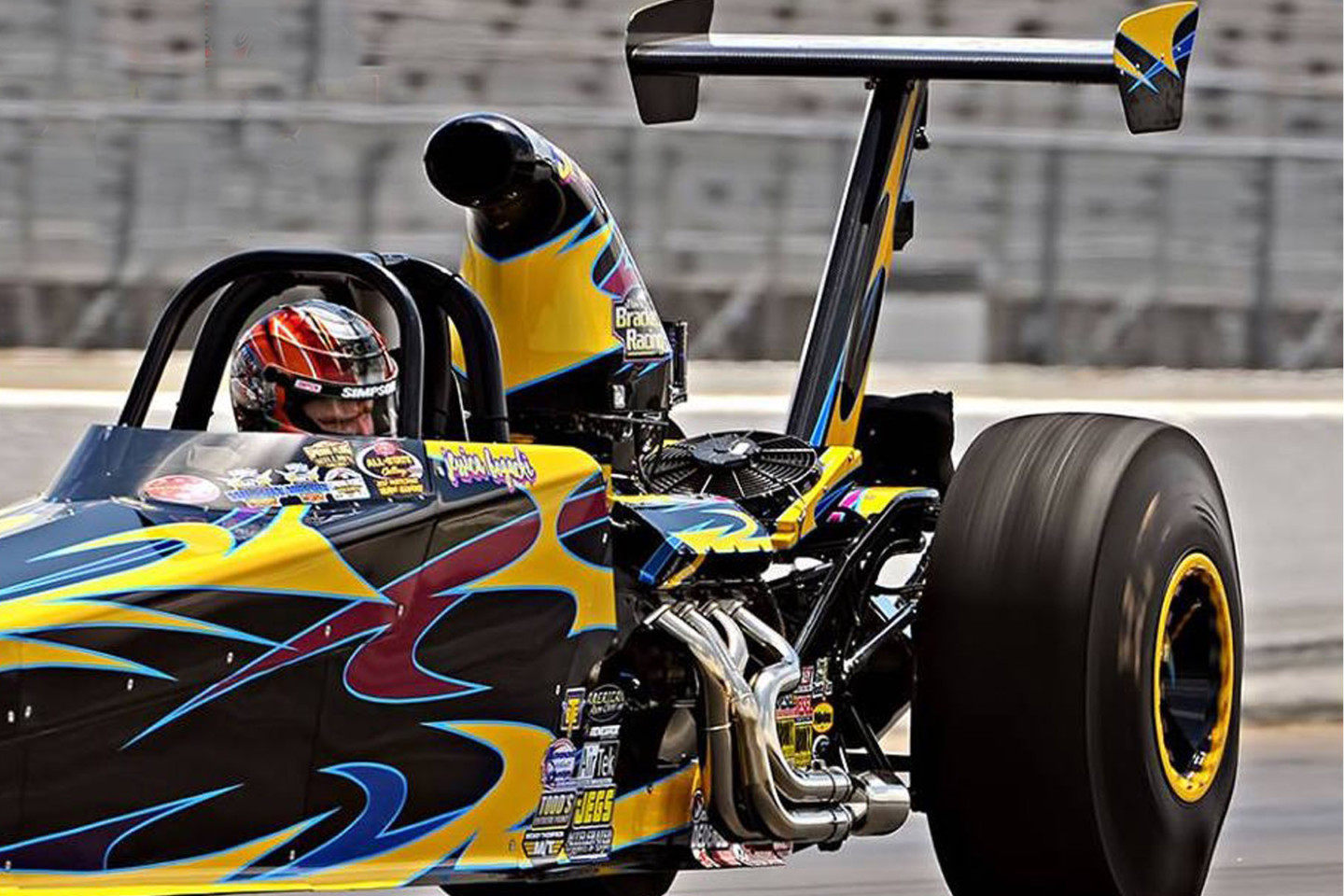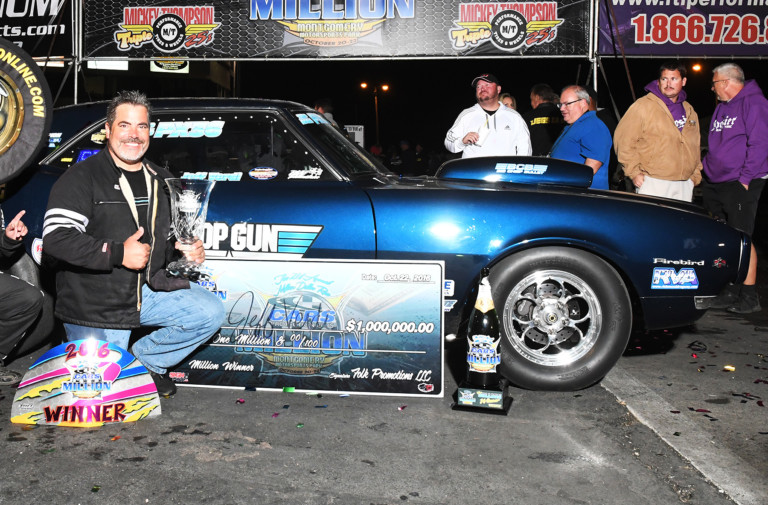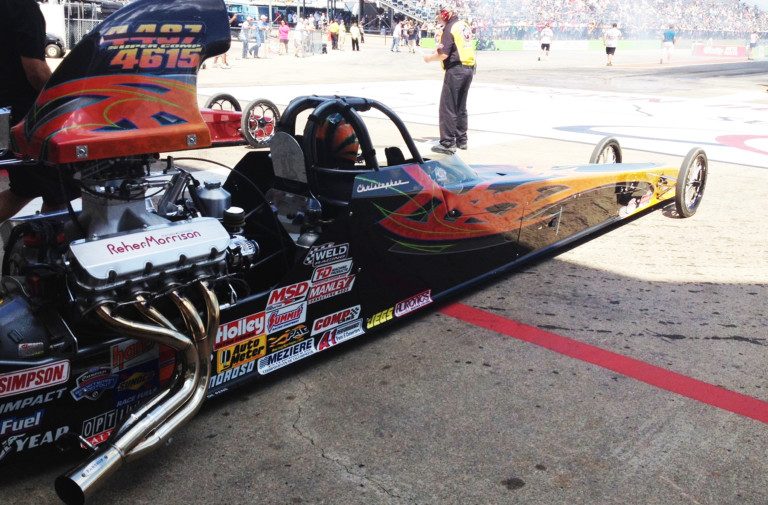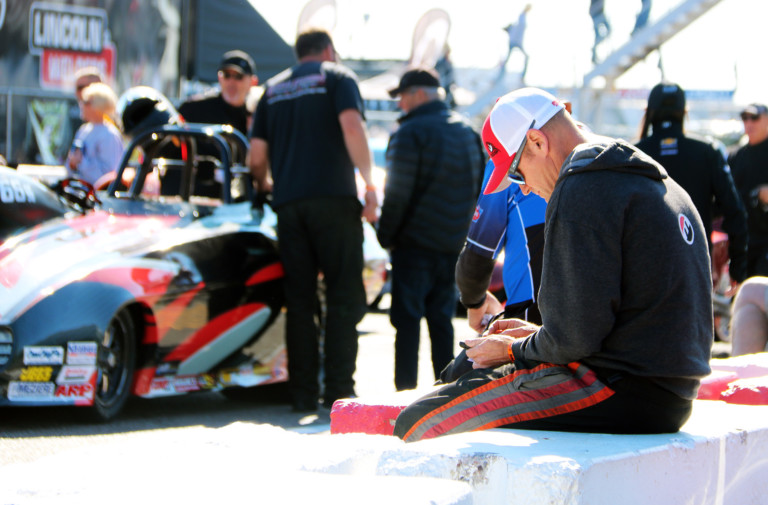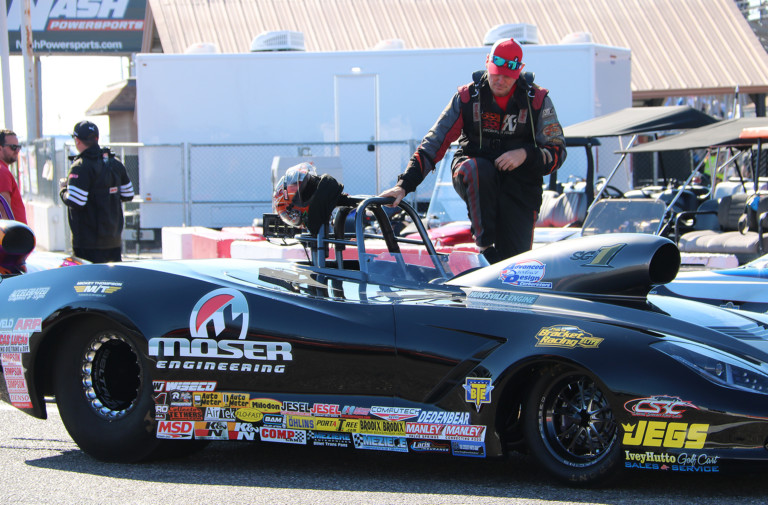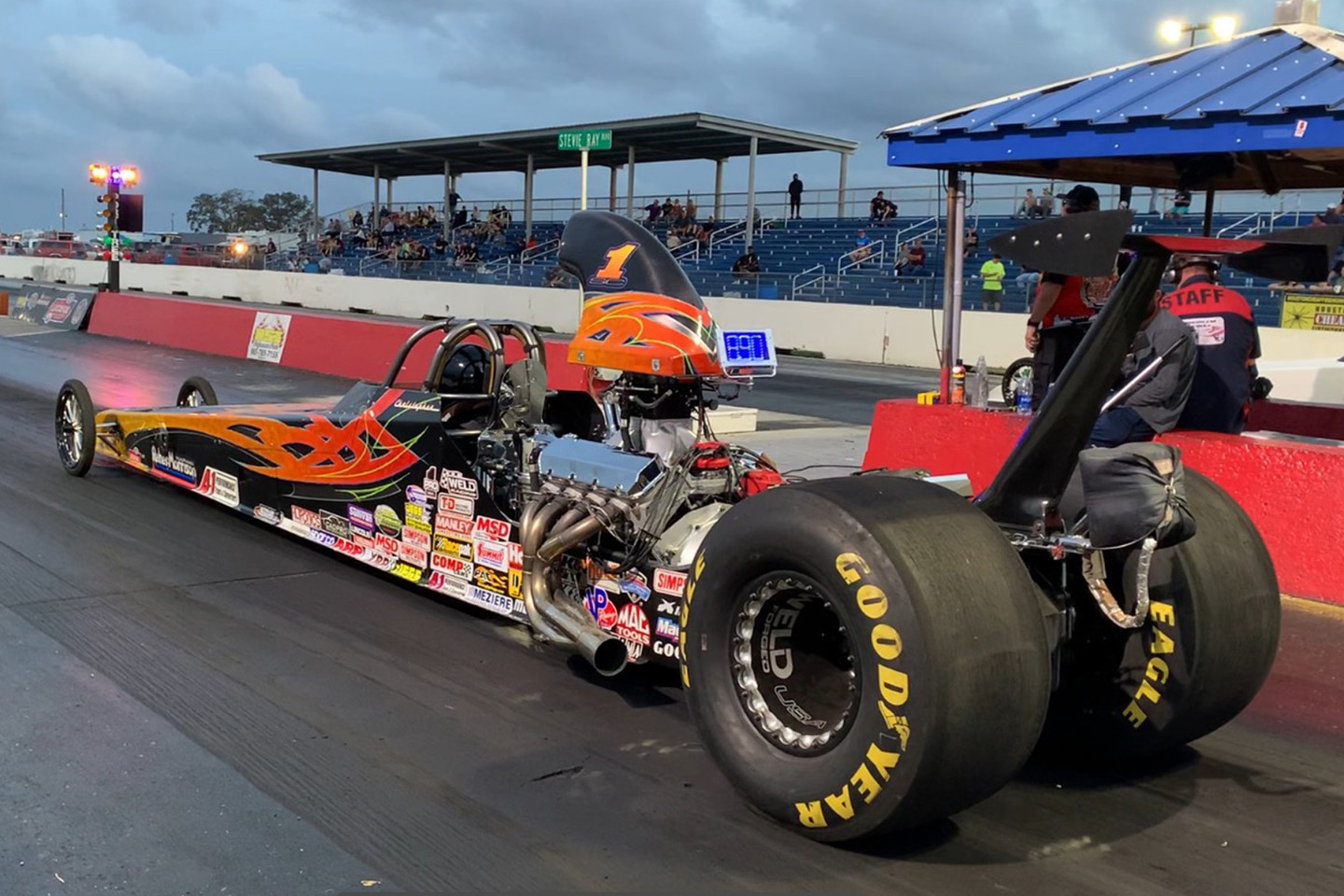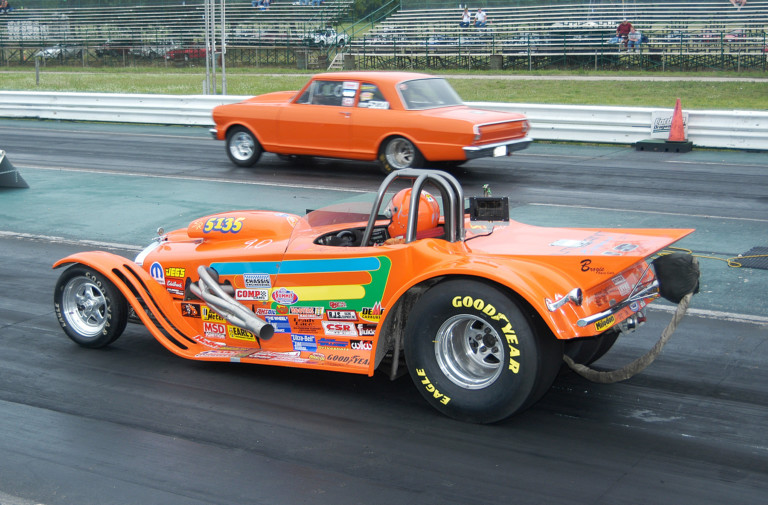Driving the finish line stripe is a tactical art, not just in bracket racing but can also help many racers from NHRA Stock and Super Stock to the .90 index Super classes. If you’re racing against an index or a handicap, you want to take the finish line, but never too much. In any case, judging “you and them” as you each charge towards the finish line is as much of an art as your starting line reaction time. Dragzine recently covered that topic in their Mastering The Cockpit story: Starting Line Advice For Your Reaction Times.
Contrasting from starting line reaction times, countless three-way strategies exist for judging you, your opponent, and the finish line in a handicapped race. We called upon three preeminent racers, Chris Dodd, Jeff Verdi, and Luke Bogacki, to share their expertise on racing the top end.
Jeff Verdi is a name many hardcore racers in the sport will recognize. On top of his overall win record, he is most notably known for taking his Firebird across the nation on an open trailer and scoring million-dollar bracket race wins on two different occasions, between Las Vegas and Alabama, just a few months apart.
Pre-Race Strategy
Verdi explains how he judges his dial-in to the thousandths of a second. “We all place a dial-in on the car based on the hundredths of a second, let’s say for example a 6.10-second dial,” he says. “But I judge what my car is going to run to the thousandths of a second.”
My whole thing is getting ready for another round, I’ll run the weather station, and it will show me a number. I use that as a guide, not the bible. – Jeff Verdi
“I’m not one of those dudes who holds back more than five (five-thousandths of a second) or more,” Verdi continues. “In other words, if I judge that the Firebird is going to run a 6.104 to a 6.106, I may put a 6.11 dial-in on the car and very slightly roll off the throttle where I know the car will kill that .006-seconds of E.T.”
Verdi explains further, “It can also depend on who I’m racing against and what I know about that racer; their reaction time reputation, and how they run their down-track game. I have a little judgment room at the finish line and trust my gut on what to do there.”
Chris Dodd is the 2021 NHRA Super Comp world champion, and his expertise on the finish line is based on his 8.90-index racing style.
On top of his 8.90-Super Comp racing, NHRA championship winner Chris Dodd enjoys bracket racing when he can. It helps keep him in practice of judging faster and slower cars. He typically has a gameplan for an opponent well established well before entering the waterbox.
“In Super Comp racing, you have the advantage of getting a feel for your opponent’s reaction time based on both cars launching at the same time (heads-up tree),” Dodd conveys. “I am very aggressive on the starting line. I have trained myself to know that in a perfect race, the ‘x’ distance between us at the moment of launch should spell out the same ‘x’ distance at the finish line. With that, I put together my finish line strategy well before I actually get there.”
I can leave any given three-day bracket race with more than 20 runs; that finish line practice is very beneficial in both heads-up or bracket racing. – Chris Dodd
Luke Bogacki offers our third bank of knowledge. Bogacki has countless big bracket racing wins along with two NHRA world championships to his credit. He is also the key figure behind his very popular This is Bracket Racing tutorial website.
Luke Bogacki, an NHRA world champion and winner of countless bracket races, tells how he thinks out each round differently. Bogacki describes, “Chasing or chased, game-planning is all part of that.”
He continues, “The second part of a good gameplan comes down to one of three down-track decisions. I want to decide first I’m going to get there first, and we both hold it wide open, second, I can’t catch him, or they’re going to go around me. I can’t get there first if we both hold it wide open or lastly, which happens more often than most of us want to admit, and it’s going to be really close.”
Knowing Your Car
“In heads-up racing, if I gauge that I left on my opponent by a fender, door handle or at another point, I should theoretically take the finish line by that same distance,” Dodd notes. “I’m using that starting line gap to judge my buffer zone as to how to hit the finish line in relationship to my opponent.”
Our three racers agree that knowing your car is critical. If you “whomp,” back off the throttle, or touch the brakes at a specific point on the track, it will equate to moving your E.T. a very specific amount.
“I know my car well enough to know exactly at what point I should either back off, touch the brakes, or run it out,” Dodd says. “I judge that starting line gap and prepare myself with a strategy for the finish line, and trust that my car will move that amount.”
Dodd remembers when he raced junior dragsters, he always struggled with finish line strategies. When he stepped into full-size race cars, he joined This is Bracket Racing, which taught him different scenarios of how to be better at the finish line.
Bogacki is flattered by Dodd’s comments and expands on them. “The biggest thing for me is to visually identify as early into the run as possible where I should be in relationship to the other car,” he comments. “Again, it’s knowing what you can do with your car at the finish line, but also judging where your gap should be early on in the race if they are, for example, two-, one- or a half-second ahead or behind in handicap.”
Realizing if I am ahead or behind your opponent at the finish line is one thing. It’s more important to make that judgment a second or two in advance of that when I have time to do something about it. – Luke Bogacki
Verdi stresses the importance of knowing his cars.
“My Firebird is pretty much right in the center of chasing or being chased,” he says. “Since most tracks keep dragsters and door cars divided until later rounds, I typically do not meet a fast dragster until I have the car’s dial-in pretty well figured out. I will typically dial honest and run it out the back door. I don’t believe there is any way to judge an opponent with two seconds or more difference in your dial-ins.”
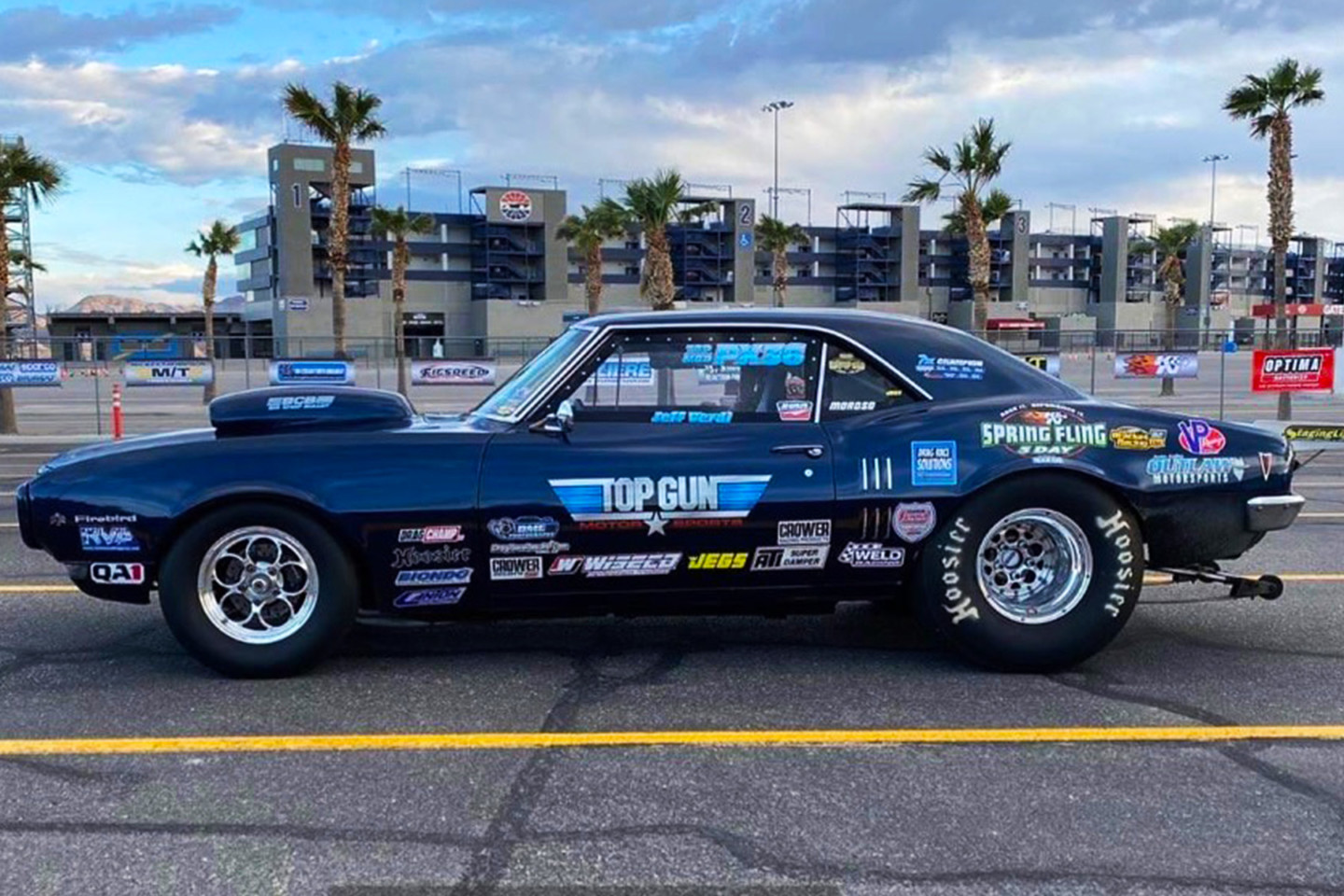
Jeff Verdi describes how he has taught himself to judge the finish line by six inches. He adds that experience is the only way to precisely know how to move your E.T. at the top end of the track.
Verdi adds, “I invest in a test-and-tune night now and then to just try stuff and continue to better know my car. I establish what my car will run, then on the next pass I will pump the throttle twice, or three times, or even precisely touch the brakes. Then I will see how the E.T. changes. I then get more and more confident on exactly how to control my car against my opponent.”
Bogacki adds a variable to the “whomping” throttle-pump process. “If I pump the throttle one time, how much did I kill? It can also depend on where you are on the racetrack. If you’re at a 1/4-mile race and you pump it at the finish line, that kills a whole lot less than if you did the same foot action at the 1/8-mile.”

Bogacki thinks the hardest thing to teach or execute is pumping the throttle. It is a trial-and-error process with every car reacting differently to the amount of distance it kills between you and your opponent.
Gadgets
Weather stations and E.T. prediction software are totally separate and critical subjects for predicting your dial-in. Since we are focusing on driver’s skills in this article, we will acknowledge their importance yet defer this complex subject for another day.
Seat Of Your Pants Driving
You may be focused on judging your opponent but being sensitive to your own car on each pass could alter your finish line strategy. Did your car act sluggish or hesitate at any point? Did you spin the tires, no matter how slight? Our experts chime in.
“I know exactly how my dragster feels off the starting line, when it shifts or comes off of the throttle stop,” states Dodd. “If I think it was just a little off, I may not change my finish line strategy; if I think it moved around a little bit or the other racer is ahead of where I think he should be, I will run it out for all it is worth.”
Bogacki gives an interesting take on knowing his different cars.
“I have made thousands of runs in my bracket Vega; when it hits the tires and might move a little at the 60-foot, I might have lost .100 in my E.T. But I learned over time and experience that, once in a blue moon, the dragster kind of rattles the tires at mid-track. My initial thought was I lost .100 but carefully reviewing each pass, the dragster just loved the wheel speed it caused. It took me time to figure that out.”
Verdi explains that it takes a big investment in time before driving a car becomes second nature.
“Both my Firebird and GTO are pretty comfortable to sit in and drive. On the other hand, I recently raced a friend’s car, and the seat, pedals, and shifter were all wrong for me. There is no way I could ever develop a second nature in that car.”
Verdi continues, “Comfort and that second-nature feeling are critical when you concentrate on your opponent. If you watch Scotty Richardson and a couple of these other guys that come around in their seat as soon as they leave the starting line, they’re looking repetitively at their opponent and easily driving their own car at the same time.”
Perfect Your Own Game
The fundamental lesson these racers stress is knowing yourself, intricately knowing your car, and developing a strategy specifically created by you where you are most comfortable.
Have you put in the practice, test and tune passes and already have strategies in place as you rocket towards the finish line? You can be guaranteed that your opponent is sizing you up, as well.
Chess is a game of thinking of your next moves steps ahead of your opponent. In this 150 MPH version of chess, it’s a matter of which one of you is thinking of their best move compared to the other racer.

